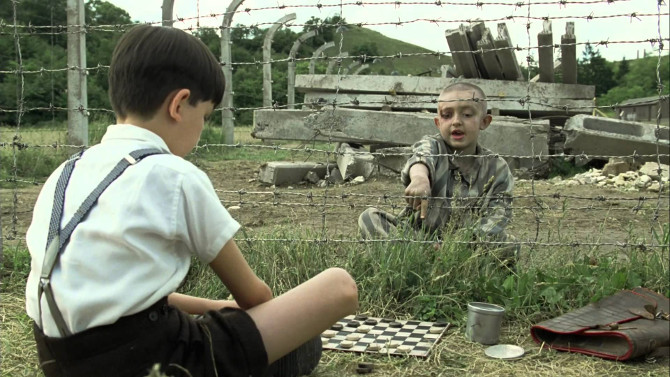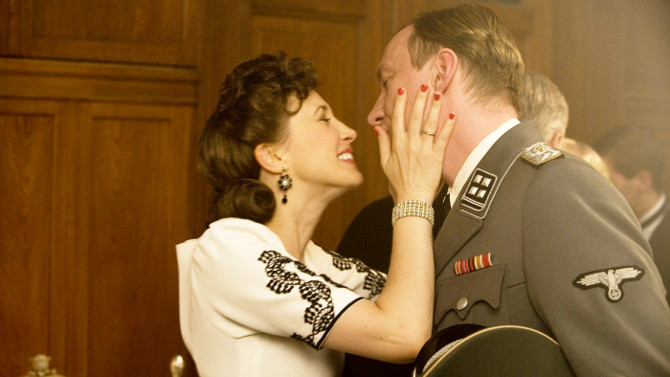An effective method of telling a dark story is often through the eyes of a child. . . and there is arguably no darker event in human history than the Holocaust. Earning praise from audiences worldwide and criticism by academics who lament its inaccuracies, The Boy in the Striped Pyjamas (2008), directed by Mark Herman (who also adapted the story for the screen, based upon John Boyne’s novel of the same name), is an emotional, poignant depiction of one of the most horrific blemishes of our collective past.
Bruno (Asa Butterfield) is an eight year old boy living in Berlin. With a father (David Thewlis) moving up in the military, a supportive mother (Vera Farmiga), and an older sister, Gretel (Amber Beattie), they are leaving their life in the big city for a cold home in the rural unknown.
The film opens with a quotation from John Betjeman, “Childhood is measured out by sounds and smells and sights, before the dark hour of reason grows”, and this is most definitely directed at Bruno. The young boy yearns to be an adventurer, something wholly out-of-sorts for his rigid military-led family. He wants to build a tire swing (which he does thanks to a young military man, Lieutenant Kurt Kotler, stationed at their home – played by Rupert Friend), read his adventure books (frowned upon by his propaganda spewing tutor – played by Jim Norton), and, perhaps more than anything else, explore the surrounding area – something strictly off limits according to his parents.
What lies just beyond the sparse woods is a concentration camp. . . yet to his innocent eyes (because, like any adventurous child, he finds a way to explore), it simply looks like a farm where everyone is wearing pyjamas with numbers on them (in his mind, there must be a game linked to this odd fact).
Finally meeting a boy near his age, Shmuel (Jack Scanlon), they begin a friendship through the barbed-wire fence. They talk numerous times, with Bruno trying to play ball games with him (but so much fear runs through Shmuel that he never participates). . . the affluent boy even starts to bring food for his hungry friend.
This kindly little soul is at odds with what Bruno has been told – a stereotypical, utterly negative slant on the Jewish people. The two do not add up, for even their Jewish servant, Pavel (David Hayman), patches him up with so much love and tenderness after an accident (and, in all of his innocence, he tells his mother, “he used to be a doctor once, but gave it all up to peel potatoes”).
Capturing the pins and needles everyone is on when a country’s ideology is so caustic it could burn through a wall of diamonds, perhaps Lieutenant Kotler is the prime example of this – seemingly crueler than most, he utilizes this as a defence mechanism for the fact that his father has fled the country. . . a tidbit that could ruin him if it was discovered. The story also depicts the ways in which the propaganda pierces the human psyche, for soon Gretel is infatuated with everything Hitler (posters adorning her bedroom wall), while she speaks of the Jews with utter disdain. Even the honest heart of the young aren’t spared, as Bruno lies about giving Shmuel some food when he is brought to the house to do some chores that only small hands can do – Bruno spouting the same mix of fear and hatred that pushes so many to make the wrong decisions when it seems like the walls are closing in, as everyone around them is saying the opposite.
Providing what one could argue as a balanced approach, Bruno’s mother knows not of what her husband is doing. . . until one fateful day, that hidden piece of information slips out, and, to put it lightly, she is disgusted. Planning on removing her children from the situation, Bruno learns that Shmuel’s father has disappeared. What will come of this most unorthodox friendship? Will Bruno leave his friend and depart with his mother and sister, or will he help his friend try to locate his lost father?
An emotional, trying tale, Herman transports us through this horrific world with the guiding light of a child. . . an example of hope and forming bonds where adults have failed. Yet, that does not mean that Bruno cannot get caught up in this world of hatred, pain, and vile murder. In many ways, this is a perfect companion piece to Guillermo del Toro’s 2006 adult fairytale Pan’s Labyrinth, which is set in a complicated World War 2 era Spain, also following a young child’s arduous journey through life’s hardships, yet provides an allegorical fantasy element which differs from the strictly historical-style perspective shown in The Boy in the Striped Pyjamas – yet both speak to the horrors that can affect even the most innocent of lives.
Handled with care by Herman, he draws us into this cold tale of the Holocaust – yet, and this can be rare for this type of film, never forgets that all the people we are watching onscreen are human beings, whether they are flawed and abhorrent, or not. They have emotions, can love and feel, and perhaps that is just as powerful a message as the horrors he depicts onscreen. . . the past is the past, and it sadly cannot be changed, but, if we can learn from our mistakes as well as forgive, that means there is still hope, a chance to get through to one another, finding a way to reach others through love and understanding rather than hatred and division – breaking down the fence that divides, much like Bruno and Shmuel do in this film. So, instead of ending with one of my typical flairs, I leave you with this quote from Anne Frank that sums things up nicely, “In spite of everything, I still believe that people are really good at heart”.


